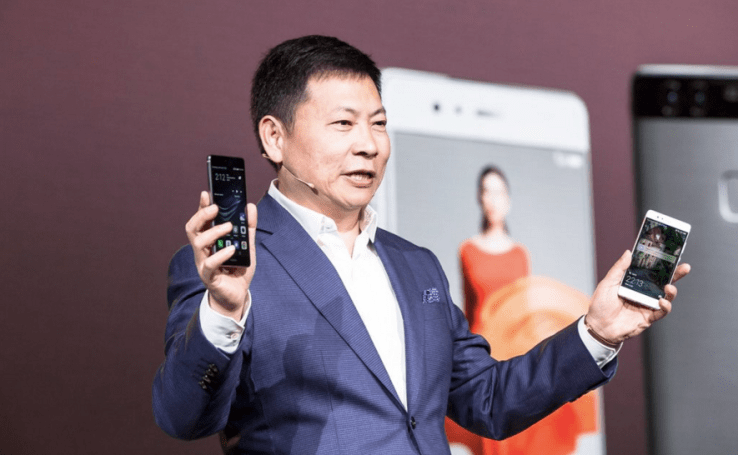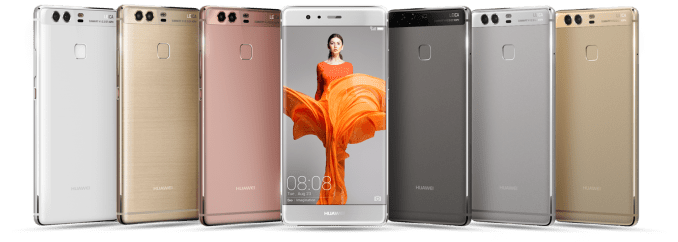Huawei outs dual-lens flagship smartphones, co-branded with Leica

The third largest smartphone maker by global marketshare, China’s Huawei, has just unveiled two new flagship handsets — announcing the 5.2 inch P9 and 5.5 inch P9 Plus at an event in London today.
The most notable feature of both are dual lenses on the rear, sitting next to the Leica brand. Huawei says the camera has been “co-engineered” with the veteran optics maker. Although that does not, apparently, mean the lenses themselves are Leica lenses.
But of course Huawei still gets to use the Leica name in its marketing, and that’s really the point here.
Despite global smartphone sales growth slowing in recent years, Huawei has managed to buck the trend and outstrip rivals — growing 53 per cent in Q4 last year, according to Gartner, its best year over year performance ever. The analyst attributed that to increased brand visibility overseas. Huawei is evidently hoping to further ramp up its brand visibility by sticking the nostalgic Leica name on the rear of its phones.
What’s the point of dual lenses? Are we seeing a return of the ill-fated attempt of a few years back when smartphone makers tried to foist 3D photography onto disinterested consumers? No, it’s not so out-and-out gimmicky as that, with the dual-lenses rather being put to work to — Huawei claims — enhance photography via improved color/clarity, and to support features such as refocusing after the fact (as Lytro previously tried with dedicated camera hardware; but as ever if it can become a feature on a smartphone it will… ).
The P9 and P9 Plus have one RGB and one monochrome lens to support the various photo enhancements being touted. Each lens has a 12 megapixel sensors. And the claim by Huawei is that the combination of twin yet different lenses allows the devices to capture more light and thus deliver better looking photos. The proof of such claims will of course be in the testing/reviewing. But the company says, for example, users will be able to create pictures with “professional bokeh” (aka the artfully blurred background effect characteristic of high end cameras).
It also says the twin lenses support a wide aperture mode that lets in more light — and more light typically means better photos.
Squeezing better performance out of smartphone cameras is the obsession of every high end phone maker worth its salt these days, since photos remain the social currency of the web — whether it’s sharing snaps on Snapchat, selfies on Instagram or pictures of your lunch via WhatsApp. People want to talk to each other via messaging apps and for a lot of the time they do it with pictures, rather than words.
Huawei is also appending the Leica brand to some filter effects, with the devices offering, for example a ‘Leica Film Mode’ that supports three photo processing styles — evidently designed to hark back to the film cameras of old. Hipsters prick your side-burned ears up…
Other Leica-branded claims focus on more true-to-life colors…
Huawei is also touting improvements to the front facing lenses on the devices, ergo better performance for snapping selfies in low light…
Elsewhere, the aluminum-encased hardware does not stray too far from Huawei’s prior flagships in terms of looks, but the phone maker has beefed up battery capacity (to a very respectable 3,000mAh) — of course another huge obsession for smartphone consumers — as well as touting having added triple antennas for what it claims is improved connection quality.
So while all these various claims remain to be proved, Huawei certainly looks to have been listening carefully to the factors consumers care around, rather than focusing on adding hardware gimmicks to its devices, such as, for example, pointlessly curved screens.
Also on board: a fingerprint reader and the latest USB type-C standard — so the Chinese mobile maker has beaten Samsung to the punch on the latter.
The two devices will go on sale starting in Europe and the Middle East on April 16, with pricing in Euros set at 599 for the 3GB + 32GB variant of the P9 or 649 for the 4GB + 64GB variant; and 749 for the P9 Plus with 4GB RAM and 64GB of storage. Stay tuned for a full review when we’ve had a chance to put the P9s through their paces.
Gartner’s Roberta Cozza told TechCrunch she expects dual lenses to land on other smartphone makers’ devices this year.
Discussing Huawei’s new flagships, she added: “The device is solid and competitive at the premium end, the focus on design was good as it is an important improve my from that point of view from previous model. As Huawei gets more convincing with technology and design in the premium end I think they need now to step up and differentiate with more unique Huawei experiences which will also help brand, as Huawei aims to penetrate more the high end they will need to become more trend setter.”


 NEWSLETTERS
NEWSLETTERS
0
SHARES